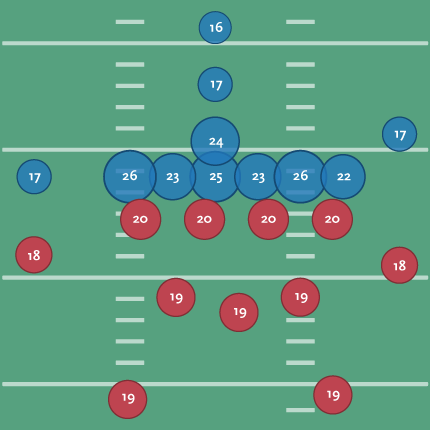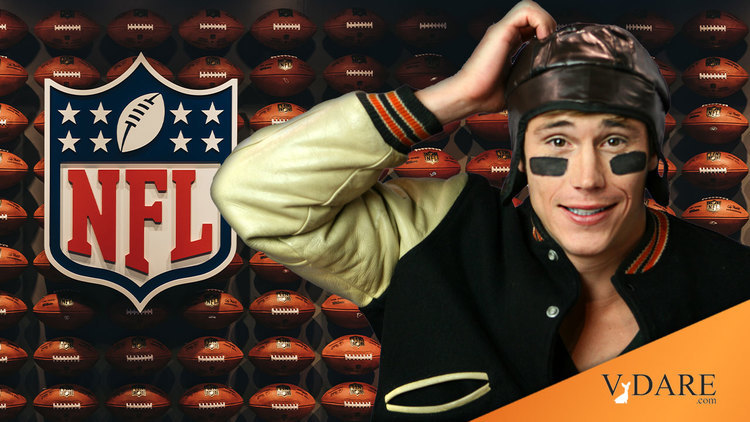

By Steve Sailer
07/21/2008
Graphical data analyst Ben Fry takes some old data provided by NFL scribe Paul Zimmerman of Sports Illustrated on the average Wonderlic IQ test scores by position of draft prospects (which I'd published in VDARE in 2003) and plots it with offense in blue, defense in red, and the radius of the circle proportional to the scores.
You can convert them to IQs assuming that 21 correct answers = 100 and add or subtract 2 IQ points for each answer above or below 21. So, quarterbacks averaged 24 right for a 106 IQ. Tailbacks averaged 16 for a 90.
Don’t get too excited about minor differences between positions: I've seen other listings of averages by position and they differed slightly. But the overall pattern was the same.
Marginal Revolution explains the graph as "The closer you are to the ball, the higher your score."
Okay, but why is that?
Because the closer you start out to the ball at the time of the center snap, the more crowded the field is around you. So, close to the ball, the more important upper body strength is and the less important footspeed is. If you are the center, say, there just isn’t much room to run and you don’t have anywhere in particular to go. You might dash a few yards forward to block the middle linebacker or backpedal a few yards to protect the quarterback, but that’s about it. On the other hand, if you are a defensive lineman, you want to get to the quarterback before he releases the ball, so footspeed is important on defense. A defensive end might take the long way around and sprint 20 yards to sack the quarterback.
Upper body strength is relatively equally distributed between the races, but footspeed most definitely is not. So, tailbacks, wide receivers, and defensive players have a need for speed, so they are disproportionately black. I haven’t checked recently, but in most recent years since Jason Sehorn’s retirement, none of the 64 NFL starting cornerbacks at the start of the season were white, and none of the 32 starting tailbacks were white. (For some reason, this never gets as much publicity as the perceived lack of black quarterbacks.)
As we all know, there is about a 15 point difference IQ gap between whites and blacks, so positions that are black dominated tend to have lower average IQs than positions that are more integrated (or that are white monopolized, such as placekicker and punter).
Another (also oversimplified, but useful) way to think about it is like this: talents are arrayed in a pyramid, with only a few people at the top.
Imagine you have a whole bunch of guys who are about 6-5 and 280 pounds. You then sort them by 40 yard dash times. The handful of extremely fast ones at the top of the pyramid of footspeed are assigned to play defensive end because they have the best chance of sacking the quarterback. The pretty fast ones in the next layer down play defensive tackle because they might sack the QB.
That leaves a lot of not very fast big guys to play offensive line. At any level of footspeed in the lower part of the pyramid, there are more people than at the top of the pyramid.
So, to differentiate among the average speed guys, you start looking more at other skills.
First, you tell them to gain 40 pounds because for pass-blocking you need inertia more than acceleration. Not surprisingly, lots of them find that why, yes, they can eat more pancakes if it means a chance to play in the NFL.
So, now you have a whole bunch of 320 pound guys who aren’t that fast. So, you look for the ones who are coordinated and relatively nimble and send the clods home. And then you look at the ones who have a lot of desire, who can play through pain, and so forth and so on.
Somewhere along in there, you look at IQ, which is useful in learning the playbook, in learning to play other positions in the offensive line, in keeping out of jail, in not getting caught taking steroids, and so forth.
Overall, because there are more people physically able to play offensive line, there is more selection pressure on non-physical attributes, such as IQ.
That then allows coaches to devise more cognitively difficult tactics for offensive linemen to execute than for defensive linemen, which in turn reinforces the need for IQ among offensive linemen. Or perhaps causality runs more in the opposite direction and the offensive line is inherently more IQ demanding than other positions. It’s kind of a chicken or egg problem.
But the important thing to keep in mind is that IQ is a relatively minor factor in the NFL relative to the ability to generate force: mass times acceleration. If you are over 220 pounds and can run the 40-yard-dash in under 4.40 seconds but have an 80 IQ, they'll try to explain the playbook to you very slowly. There are 150 million people in America with 3 digit IQs, but only a tiny number of them have the combination of size and speed to play in the NFL.
This is a content archive of VDARE.com, which Letitia James forced off of the Internet using lawfare.